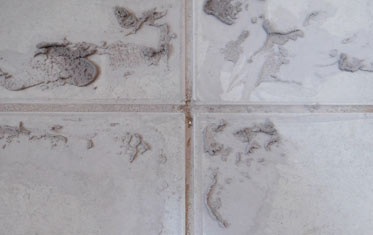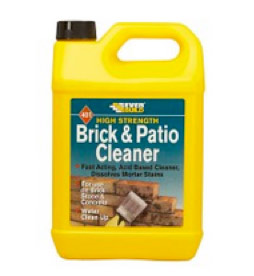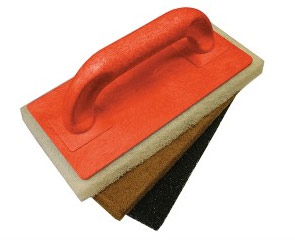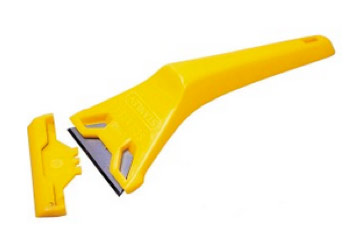How To Clean Grout From Tile Surface
Cleaning Grout When Hard – How to Clean off and Remove Grout From a Tiles Surface That has Gone Hard
If you are grouting ceramic or porcelain wall or floor tiles, it can be easy to leave small lumps of grout on the tiles surface and around the joints. If this is not removed then it can quickly harden and make the overall job look tatty and unattractive. In this DIY project guide we show you some handy tips on how to dissolve or remove hardened grout from tiles, without damaging the tiles surface. In some cases the hard grout may have damaged the tile to the point that it cannot be saved, with this in mind, we also show you how to removed a single tile and replace it with a new one.
Grout for either wall or floor tile, dries very quickly and can be a very frustrating and time consuming job to remove but don't despair! A very popular question that we receive here at DIY Doctor is: I have left the grout on my tiles for too long and now it's hard. How can I remove it?
There are essentially only three things that can be done to remove the hardened grout from your wall or floor tiles:
- Scrape, scratch and rub the Grout off the tiles
- Dissolve the grout (without affecting the tile)
- Replace the tile(s) if you can't get the hardened grout off
You shouldn't need to get to the last alternative but you will probably have a long and frustrating job ahead of you. In practice, to remove the grout from your tiles you will have to use a combination of both scraping, rubbing, and dissolving the grout.
Grout takes time to become fully hardened, so the quicker that you can get to the better. The main ingredient of most grouts is Portland Cement so it will set very hard indeed. Avoid the temptation to chip it off quickly; this is likely to result in damage to the tile.
The Basic Method for Hardened Grout Removal
Use warm water and wipe it over the surface of the tiles with a sponge. Then using some fine wire wool, rub gently over the grout which will begin to dissolve and rub off at the same time. Once the tile is clean and has no more hardened grout, wipe over with a damp cloth and leave to dry. Once you have done this polish the tile with a dry cloth to finish the job.
The same method will apply to floor, or quarry tiles but warm water will probably not be enough to dissolve the cement-based adhesives used for these tiles. A patio, or brick cleaner will do the trick but you will need to wear rubber gloves and eye protection as these cleaners are acid based.
Before you go ahead and clean the desired area, try a tiny drop in an out of the way corner to make sure that the cleaner is not too strong for the tiles and glaze as this will etch then and ruin them.
The container for your brick or patio cleaner will also state clear rinsing instructions. You will need to follow these carefully and fully.

Grout on a ceramic tiles that has hardened
Solutions for Dissolving the Hardened Grout
Even if you opt to scrape and rub away the grout, you will need to lubricate it. We prefer warm water as this will certainly not harm the tile while it will also start to loosen the grout.
We do recognise that this might not be enough to shift your grout so there are a few other options. Before using these you should test them on a small area that is out of sight, to make sure you know the effect on the tiles.
Here are some of the more popular solutions that people use to assist the removal of hard grout:
- Sugared Water – (not to be confused with sugar soap). Add some normal white sugar to some warm water and stir it in. It should be in the ratio of approximately 1 part sugar to 10 parts water, but you should experiment to see what is most effective. You should sponge the sugar water into the grout you want to remove and then leave for an hour or so then you can try rubbing and scraping off the grout, while applying more sugared water to keep it lubricated. We have not tried this, but have it on good authority that it works well. It will certainly be kind to the tile, which is a very important factor
- Vinegar – Vinegar is an acid and therefore you need to be careful that you do not damage the tile surface. Test it first to see how the tile copes and make sure that you have plenty of water to dilute and wash off any excess vinegar that gets where it shouldn't. Do not let the vinegar sit on the surface of the tile, and wear gloves. Keep the area ventilated. Continue to scrape the grout while applying small amounts of vinegar until all the hardened grout has been removed. Then wash the whole area down thoroughly
- Other Acids and Sulfamic Acid – These are more powerful acids and the process is the same as with vinegar. Make sure that you test first to ensure you don't ruin your tiles. Make sure the area is well ventilated and you have gloves and goggles on. Watch out for splashes and flicks of acid – these need to be washed off whatever surface they land on immediately with the water you will have handy
- Brick and Patio Cleaners – As described above, these are great agents for loosening and dissolving hardened grout. Take the same precautions as these are acid based cleaners, which is why they are effective. Brick cleaner can be bought in 1 – litre tubs so you do not have to buy the 5 litre tubs you see in most DIY Stores

Everbuild brick and patio cleaner – Available in our online store
How to Scrape, Scrub and Rub Hardened Grout from Your Tiles
This is the primary method for getting the grout off your tiles, but we suggest that you always use a lubricant of some sort, hence wh mentioned these first. The lubricant will not completely dissolve the grout; it will help, but really the only way to get it off is with some old fashioned elbow grease! It will reduce the likely hood that you will damage the tile surface to a degree also.
There is no ideal method and tool for scraping away the hardened grout, so you will have to approach this particular task with an element of trial and error. When working on this basis, again, it is important to first test your method on an area, which is relatively inconspicuous before attacking the whole project. You need to be sure that you are not going to do any lasting damage.
We suggest that you start "soft" and work up using tougher and more abrasive materials as you go. Here are some of the most common tools that you might consider using:
- Sponge – Use a sponge on particularly delicate and expensive tiles as this is the least likely to cause any damage. A sponge is not very abrasive, therefore it will require more time and effort to remove the set grout from the tile surface
- Nylon Scouring Pad – This is more abrasive than a sponge and therefore will be able to work at the surface of the hardened grout more effectively, but this might also cause damage to thes tile surface too, so you will need to be a little more careful. The Faithfull Scouring pads in the image on the below come in fine, medium and coarse grades which make them ideal for this kind of work
- Wire Wool – This is an ideal abrasive for removing hard grout, but it can also scratch the tile surface so needs to be used with care and time. Wire wool is also metal which can leave marks often called "metal marks" which you will need to remove
- Razor Blade or Razor Scraper – This is an ideal tool for removing thin smears of grout that have dried on the surface of ceramic and glass tiles. Because the tile surface is smooth the grout can be scraped off with little risk of damaging the tile relatively easily. You are highly likely to get metal marks which will need to be cleaned off. Do this with any kitchen or bathroom cream cleaner and a nylon scouring pad. The window scraper shown in the image is ideal if the grout is not too heavy on the floor and works brilliantly if there is just a thin film. The window scraper allows you to stay at a very shallow angle to avoid damaging the tile, see below
- Wood – Wood is a perfect material for using as a scraper to remove the hardened grout after you have moistened it, generally with warm water. Hardwood will be even "stronger" at getting the most firmly stuck grout off the tiles. Use an off-cut to scrape at the grout
- Metal Scraping Tools – If needs must you can use these, but generally it is not advisable for the damage that they are likely to do to the tile surface. If you are resorting to metal tools, we suggest that an (old) sharp chisel should be used at an acute angle

Faithfull scouring pad holder – Available in our online store

Window or glass scraper – Available in our online store
How to Scrape Dried Grout off Tiles
When it comes to scraping the grout off the tiles, you should use whatever tool you have selected at the most acute angle possible as this will apply least pressure and stress to the tile surface, reducing the chance of damaging the tile.

Scraping Hardened Grout from a Tile – keep the angle of the scraper as acute as possible
In some cases the effort of removing the hardened grout will be immense and very time consuming. In these cases you might consider simply replacing the tile, as this might well be quicker, or perhaps your efforts to remove the dried grout have damaged the tile.
Replacing a Single Tile in Situ
If someone else has laid your tiles, the problem of removing the grout will generally fall to them; therefore we are going to assume that you have laid the tiles yourself. This should mean that you have matching tiles readily available to swap the damaged one with.
To replace the tile, you will first need to break the old one in situ and then remove it from the wall or floor. Start by removing the surrounding grout with a grout rake so that all joints are clear then use a drill to drill out as much of the tile as possible and then use a cold chisel or similar to remove the remaining tile pieces and adhesive. Once this is done, you can then put in your new tile.
If you would like some more information on this we have a complete project on replacing a tile which goes into more details should you need it.
If you didn't do the work, and don't want to do this project yourself, you will need to ensure that you have a suitable replacement tile, which can sometimes be hard to come by. If you do have the right tiles, any professional tiler will easily be able to do this for you. You can find a vetted local tiler here.
Cleaning Grout from Joints
Often when you have left grout too long in and around the actual joints, they will look scarred and untidy. To rectify this they can be raked out a little using a grout rake and then they can be repointed. This will make them look much nicer and tidier.
If you are doing this job on the floor (working with floor tiles) it is well worth wearing knee pads. As this is not a quick job, the time that you spend resting on your knees will make them ache a great deal, so pads will certainly help to reuce this. Also, always wear safety goggles for this type of job.
This is ceratinly not the most enjoyable job in the world so at least make yourself comfortable.
Why not go to our video section on grouting and watch a short film on sanded grout to learn more on how to use this particular grout.
All project content written and produced by , founder of DIY Doctor and industry expert in building technology.
How To Clean Grout From Tile Surface
Source: https://www.diydoctor.org.uk/projects/cleangrout.htm
Posted by: browntoosed.blogspot.com

0 Response to "How To Clean Grout From Tile Surface"
Post a Comment